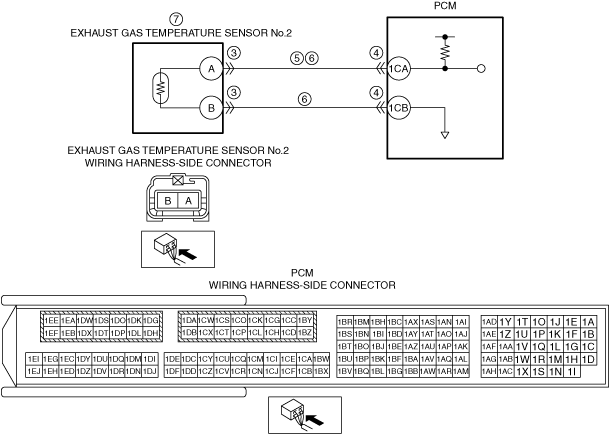|
1
|
RECORD VEHICLE STATUS WHEN DTC WAS DETECTED TO UTILIZE WITH REPEATABILITY VERIFICATION
-
Note
-
• Recording can be facilitated using the screen capture function of the PC.
• Record the freeze frame data/snap shot data.
|
—
|
Go to the next step.
|
|
2
|
VERIFY OTHER RELATED DTCs
• Switch the ignition OFF, and then switch it ON (engine off).
• Display the DTCs using the M-MDS.
• Has any DTC other than P2033:00 been stored?
|
Yes
|
Repair the malfunctioning location according to the applicable DTC troubleshooting.
|
|
No
|
Go to the next step.
|
|
3
|
INSPECT EXHAUST GAS TEMPERATURE SENSOR NO.2 CONNECTOR CONDITION
• Switch the ignition OFF.
• Disconnect the exhaust gas temperature sensor No.2 connector.
• Inspect the connector engagement and connection condition, and inspect the terminals for damage, deformation, corrosion, or disconnection.
• Is the connector normal?
|
Yes
|
Go to the next step.
|
|
No
|
Repair or replace the connector, then go to Step 8.
|
|
4
|
INSPECT PCM CONNECTOR CONDITION
• Disconnect the PCM connector.
• Inspect the connector engagement and connection condition, and inspect the terminals for damage, deformation, corrosion, or disconnection.
• Is the connector normal?
|
Yes
|
Go to the next step.
|
|
No
|
Repair or replace the connector, then go to Step 8.
|
|
5
|
INSPECT EXHAUST GAS TEMPERATURE SENSOR NO.2 SIGNAL CIRCUIT FOR SHORT TO POWER SUPPLY
• Verify that the exhaust gas temperature sensor No.2 connector and the PCM connector are disconnected.
• Switch the ignition ON (engine off).
-
Note
-
• Another DTC may be stored by the PCM detecting an open circuit.
• Measure the voltage at exhaust gas temperature sensor No.2 terminal A (vehicle wiring harness side).
• Is the voltage 0 V?
|
Yes
|
Go to the next step.
|
|
No
|
Refer to the wiring diagram and verify if there is a common connector between exhaust gas temperature sensor No.2 terminal A and PCM terminal 1CA.
If there is a common connector:
• Inspect the common connector and terminals for corrosion, damage, or disconnection and the common wiring harnesses for short to power supply to determine the malfunctioning location.
• Repair or replace the malfunctioning location.
If there is no common connector:
• Repair or replace the wiring harness which is shorted to the power supply.
Go to Step 8.
|
|
6
|
INSPECT EXHAUST GAS TEMPERATURE SENSOR NO.2 CIRCUIT FOR OPEN CIRCUIT
• Verify that the exhaust gas temperature sensor No.2 connector and the PCM connector are disconnected.
• Switch the ignition OFF.
• Inspect the wiring harness for continuity between the following terminals (vehicle wiring harness side).
-
― Exhaust gas temperature sensor No.2 terminal A and PCM terminal 1CA
― Exhaust gas temperature sensor No.2 terminal B and PCM terminal 1CB
• Is there continuity?
|
Yes
|
Go to the next step.
|
|
No
|
Refer to the wiring diagram and verify if there is a common connector between the following terminals.
• Exhaust gas temperature sensor No.2 terminal A and PCM terminal 1CA
• Exhaust gas temperature sensor No.2 terminal B and PCM terminal 1CB
If there is a common connector:
• Inspect the common connector and terminals for corrosion, damage, or disconnection and the common wiring harnesses for an open circuit to determine the malfunctioning location.
• Repair or replace the malfunctioning location.
If there is no common connector:
• Repair or replace the wiring harness which has an open circuit.
Go to Step 8.
|
|
7
|
INSPECT EXHAUST GAS TEMPERATURE SENSOR NO.2
• Inspect exhaust gas temperature sensor No.2.
• Is exhaust gas temperature sensor No.2 normal?
|
Yes
|
Go to the next step.
|
|
No
|
Replace exhaust gas temperature sensor No.2, then go to the next step.
|
|
8
|
VERIFY THAT REPAIRS HAVE BEEN COMPLETED
• Reconnect all the disconnected connectors.
• Refer to the [MEMORY CLEARING PROCEDURE] and clear the DTC.
• Perform the KOEO or KOER self-test.
• Has DTC P2033:00 been recorded?
|
Yes
|
Repeat the inspection from Step 1.
• If the malfunction recurs, replace the PCM, then go to the next step.
|
|
No
|
Go to the next step.
|
|
9
|
VERIFY OTHER DTCs
• Has any other DTC or pending code been stored?
|
Yes
|
Repair the malfunctioning location according to the applicable DTC troubleshooting.
|
|
No
|
DTC troubleshooting completed.
|
